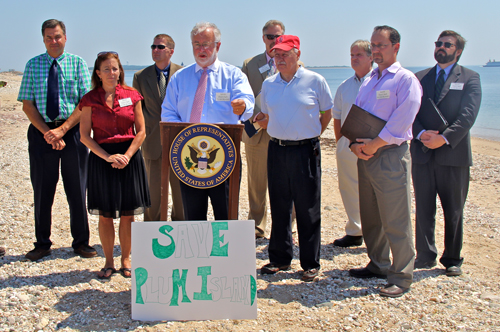Column: Mr. Bishop, gift, don’t sell, Plum Island

In a strong showing of bipartisanship and environmental activism, a coalition of pols and tree huggers gathered on a rocky beach overlooking Plum Island in sweltering heat Tuesday morning to support Congressman Tim Bishop’s “Save, Don’t Sell Plum Island Act of 2013.” It was an all-around love fest.
Later that same day, the Southampton Democrat filed his new bill in the House of Representatives in Washington. Which is where the love fest, no doubt, will come to a crashing end, given the economic and political forces that stand in the way.
In his favor, Mr. Bishop does boast co-sponsorship from colleagues from Connecticut and Staten Island, and Senator Richard Blumenthal (D-CT) plans to co-sponsor in the Senate. And, according to the congressman, New York’s two U.S. senators, Democrats Chuck Schumer and Kirsten Gillibrand, have expressed support for the legislation, which could be key given Mr. Schumer’s new-found political clout following his recent inauguration and immigration coups.
But make no mistake, it will be a long, hard and possibly impossible road from sponsorship to passage. There’s a great deal of money at stake as the feds pursue the sale of Plum Island to help offset the $1.2 billion price tag for the proposed National Bio-and-Agro Defense Facility (NBAF) in Manhattan, Kan. (The Bishop bill simply unhooks the sale of Plum Island from the development of NBAF.) Never mind that it makes no sense to relocate our nation’s animal disease research and prevention efforts from an isolated island off the East Coast to the middle of cattle country. Visions of dollar signs do dance in the heads of the bureaucrats from Homeland Security and General Services, who propose selling the 840-acre island at public auction so it can be developed, they speculate, with 500 luxury homes. Yes, I know, it’s a ridiculous idea, but that’s what could happen if something doesn’t give. And, hopefully, the first thing to give will be the Southold Town Board’s rezoning of the property to take residential development out of the equation. That, in itself, will make the sale of Plum Island much less attractive to any private investor who faces the tens of millions of dollars in environmental mitigation that’s likely to follow.
My personal first choice for the property, if the Plum Island lab’s mission eventually is moved to Kansas, would be to have it become a National Wildlife Refuge. But if that’s not in the cards, how’s this for an idea with an obvious local precedent?: Have the feds gift the island to Southold Town, just as the feds gifted the Grumman property in Calverton to the Town of Riverhead back in the mid-1990s. Yes, I know, the situations aren’t entirely analogous — largely because Grumman paid Riverhead $1.3 million a year in lieu of taxes and Plum Island doesn’t pay Southold a cent — but wouldn’t you rather have the fate of our neighbor to the immediate east in the hands of the town council instead of the mooks in Washington?
And Tim Bishop can start this ball rolling by renaming his new bill the “Gift, Don’t Sell Plum Island Act of 2013.”
•
This is my first column since the socko four-day Independence Day weekend, so please allow me to go back in time to Sunday, July 7, 2013, when its full benefits and costs could be measured in that microcosm of the North Fork’s tourism-based economy: the Village of Greenport.

If you spent any time in the village over the holiday weekend, you already are aware of the benefits: oodles of visitors spending oodles of money in just about every shop, gallery, restaurant, micro-brewery and anywhere else tourists can be separated from their cash. If your Greenport business didn’t make money that weekend, it’s doubtful that it ever will.
But with all those visitors came a cost, which is perhaps best illustrated by the photograph that accompanies this column. It was taken on Main Street on Sunday, July 7, and it’s unfortunately representative of overflowing trash cans and litter on the sidewalks and streets throughout the village that morning. Said eyesores could have been anticipated, I think, and avoided with a little advance planning by village fathers and mothers. Is that really a sight Greenport wants its visitors to experience first thing on a sunny Sunday morning in July? I don’t think so, and neither do the village merchants I’ve spoken to about this problem.
Two or three teens working an hour or two for minimum wage on summer weekends could eliminate Greenport’s trash/litter issues once and for all. So what’s the hold up?








